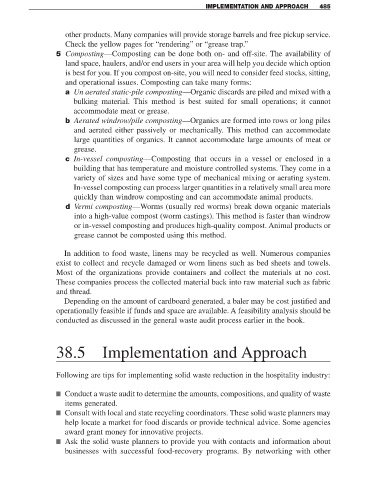Page 507 - Solid Waste Analysis and Minimization a Systems Approach
P. 507
IMPLEMENTATION AND APPROACH 485
other products. Many companies will provide storage barrels and free pickup service.
Check the yellow pages for “rendering” or “grease trap.”
5 Composting—Composting can be done both on- and off-site. The availability of
land space, haulers, and/or end users in your area will help you decide which option
is best for you. If you compost on-site, you will need to consider feed stocks, sitting,
and operational issues. Composting can take many forms:
a Un aerated static-pile composting—Organic discards are piled and mixed with a
bulking material. This method is best suited for small operations; it cannot
accommodate meat or grease.
b Aerated windrow/pile composting—Organics are formed into rows or long piles
and aerated either passively or mechanically. This method can accommodate
large quantities of organics. It cannot accommodate large amounts of meat or
grease.
c In-vessel composting—Composting that occurs in a vessel or enclosed in a
building that has temperature and moisture controlled systems. They come in a
variety of sizes and have some type of mechanical mixing or aerating system.
In-vessel composting can process larger quantities in a relatively small area more
quickly than windrow composting and can accommodate animal products.
d Vermi composting—Worms (usually red worms) break down organic materials
into a high-value compost (worm castings). This method is faster than windrow
or in-vessel composting and produces high-quality compost. Animal products or
grease cannot be composted using this method.
In addition to food waste, linens may be recycled as well. Numerous companies
exist to collect and recycle damaged or worn linens such as bed sheets and towels.
Most of the organizations provide containers and collect the materials at no cost.
These companies process the collected material back into raw material such as fabric
and thread.
Depending on the amount of cardboard generated, a baler may be cost justified and
operationally feasible if funds and space are available. A feasibility analysis should be
conducted as discussed in the general waste audit process earlier in the book.
38.5 Implementation and Approach
Following are tips for implementing solid waste reduction in the hospitality industry:
■ Conduct a waste audit to determine the amounts, compositions, and quality of waste
items generated.
■ Consult with local and state recycling coordinators. These solid waste planners may
help locate a market for food discards or provide technical advice. Some agencies
award grant money for innovative projects.
■ Ask the solid waste planners to provide you with contacts and information about
businesses with successful food-recovery programs. By networking with other

